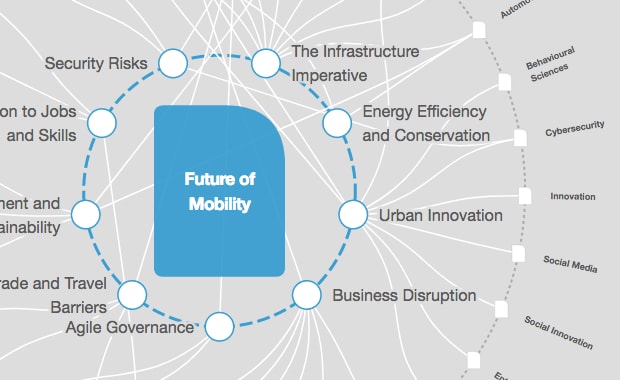3 ways sustainable transport can prolong the COVID-19 effect on air pollution

Image: REUTERS/Rodrigo Garrido

Explore and monitor how Mobility is affecting economies, industries and global issues
Stay up to date:
Mobility
- Reducing transport emissions is crucial to our long-term climate ambitions.
- Electrifying public transit can help lock-in the reductions in emissions and air pollution caused by the pandemic.
- Here are three places for cities and policy-makers to start this process.
If the coronavirus pandemic has a silver lining, it’s likely the fact that, for a while at least, we didn’t need to squint through smog to view that lining. Warnings of environmental disaster have been replaced by remarkable photographs showing the demonstrable difference in air quality caused by a few weeks of drastically reduced fossil fuel consumption and CO2 emissions, everywhere from China and India to Europe and the US.
Given that transportation is one of the biggest sources of air pollution, remaking transit in a post-COVID world is a crucial step toward reducing emissions in the long-term.
But how do we hold onto that progress as life gradually starts returning to normal, at least in some cities? Already we can see pollution rising again in countries where residents have gone back to work. Here are three key ways sustainable transit can prolong the COVID-19 effect on reducing air pollution.
1. Cities for people, not cars
Several cities have already begun using the pandemic lockdown as a springboard for embracing the multiple modes of mobility used by their residents, expanding space for biking and walking, and even just sitting outside at a cafe.
In northern Italy, Milan – hard hit by both COVID-19 and air pollution – has announced a citywide experiment: an expansion of cycling and walking space along 35 km (22 miles) of streets that includes temporary bicycle lanes and widened sidewalks.
European cities and national governments have allocated at least €823 million ($973 million) to active mobility and announced over 1,200 km of cycling infrastructure since the beginning of the coronavirus recovery phase, including in Brussels, one of Europe’s most congested cities, and Paris.
And it’s not just Europe. In California’s Bay Area, San Francisco and Oakland have also opened some streets to pedestrians and cyclists, and in Australia, Melbourne is fast-tracking 40 km of new bike lanes.
There are a lot of downsides to 2020, but it’s also an excellent time for cities to usher in a new phase of urban renewal, one that prioritizes people instead of cars.

2. Public transit remains an essential service
Public transit trends, from ridership levels to changing preferences for the bus over the subway, are in flux. But what remains constant is that public transit must continue to be the backbone of urban transportation.
If driving a car becomes an increasingly viable alternative to walking, biking or taking the bus or train, that’s a problem – not just for the public transit industry, but for everyone who wants to avoid congestion, breathe clean air and facilitate greater equality. Public transit is an essential service for the many people who rely on it to access necessary services such as healthcare and schools as well as to carry out essential jobs.
It’s important for cities to continue measures aimed at minimizing infection on public transit, such as mask wearing and rear-door boarding, and to make public transit as efficient as possible, using infrastructure solutions like bus rapid-transit lanes and expanded sidewalks as well as software solutions that make it easy to adjust routes and timetables to avoid crowding while meeting demand.
Planning and scheduling solutions to prevent overcrowding include adding buses on popular routes at popular times of day and working with local authorities to provide service for staggered start and end times at school and work, rather than retaining crowded peak times.

3. Electric buses: Complex but critical
Electric buses produce significantly lower greenhouse gas emissions than diesel, diesel-hybrid and natural gas-powered buses. In the US alone, replacing all the diesel-powered transit buses with electric buses could eliminate more than 2 million tons of greenhouse gas emissions each year.
Globally, Bloomberg New Energy Finance projects that just under 60% of municipal buses around the world will be electric by 2030 – and that electric vehicles of all types will displace demand for 17.6 million barrels of oil per day by 2040.
That’s why some cities are beginning to mandate the adoption of electric buses. The vast majority of electric buses in the world are in China – which has more than 400,000 electric buses, about 99% of the world’s total – but change is coming to the rest of the world, too.
In Europe, binding EU rules set minimum national procurement targets for new clean buses and trucks for 2025 and 2030. In the US, California has led the shift toward the electrification of bus fleets, and California agencies like Antelope Valley Transit Authority are paving the way by electrifying their entire fleet without waiting until the 2029 deadline. Fifteen states and Washington, D.C., announced this summer that they will be following California’s lead.
Though the environmental benefits are clear, some obstacles remain. For one, though the long-term costs of operating and maintaining electric buses are lower than for diesel buses, the initial cost of purchasing an electric bus is higher. Transportation providers also need to have the necessary charging infrastructure in place.
The hurdles go beyond hardware, however. It’s more challenging to schedule electric buses because they need to stop more frequently to recharge than diesel buses can drive before refilling the gas tank.
For non-electric fleets, the optimization algorithms behind the scenes already take into account complicated variables like the number of vehicles and drivers available and the frequency and length of the breaks that drivers need to take throughout the day.
With electric buses, the complications mount, because the algorithms need to take into account a lot more variables, such as when buses need to be charged, where they should charge, how long it will take, and how to schedule trips around those charging times. These are complex calculations, making the use of transportation-scheduling technology all the more critical.
It’s important to remember that while individuals switching to electric cars for personal use may reduce their own carbon footprint, those cars require no less road space or parking infrastructure than their gas-powered counterparts. For electric vehicles to make as much of a difference as possible, it’s important to prioritize electrifying those that carry the most people. The transition to electric bus fleets – initially through the use of mixed fleets, in which only some buses are electric, and eventually through all-electric fleets – is capable of reducing both emissions and congestion.
Now is the time to shape more livable cities, where we can breathe clean air and move freely. Now is the time to build on the unintended environmental side effect of pandemic lockdowns, keeping emissions and congestion down by limiting incentives and land use allocation that serve cars – and instead focusing on the multiple modes of mobility that serve people.
Don't miss any update on this topic
Create a free account and access your personalized content collection with our latest publications and analyses.
License and Republishing
World Economic Forum articles may be republished in accordance with the Creative Commons Attribution-NonCommercial-NoDerivatives 4.0 International Public License, and in accordance with our Terms of Use.
The views expressed in this article are those of the author alone and not the World Economic Forum.
Related topics:
Forum Stories newsletter
Bringing you weekly curated insights and analysis on the global issues that matter.
More on Nature and BiodiversitySee all
Andrea Willige
November 10, 2025
Marco Lambertini and Marcelo Bicalho Behar
November 6, 2025
Tom Crowfoot
November 5, 2025
Laura Fisher, David Mueller and Anika Duggal
November 5, 2025





